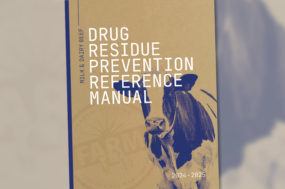The theme at the 2010 ADSA Transition Cow Discovery Conference could have been “Lean Is In.” Jim Drackley from the University of Illinois, Mike Allen from Michigan State University, and Phil Garnsworthy from the University of Nottingham shared some very interesting research results related to energy metabolism.
Additionally, at the Western States Large Herd Management Conference, Rodrigo Bicalho from Cornell University’s veterinary school presented a “counterpoint” where thinness could precede lameness.
Drackley stated that cows consuming too much energy during the dry period respond metabolically as if they are too fat, even if they don’t appear to be. He shared the results from a study where 18 non-pregnant, non-lactating Holstein cows were fed either a low-energy (LE, ~ 0.60 Mcal NEL per lb) or high-energy (HE, ~ 0.70 Mcal NEL per lb) diet for 56 days.
The cows were then slaughtered and their internal fat stores dissected and weighed. Cows fed the HE diet had more than 50 pounds of additional internal fat in their omental, mesentery and perirenal areas than those fed the LE diet.
Thinner cows – body condition score (BCS) < 3.5 – fed the HE diet accumulated significantly greater amounts of visceral fat than those fed the LE diet, while the internal fat stores did not differ in fatter cows (BCS ≥ 3.75) fed either diet.
These fat deposits are thought to be particularly metabolically harmful since they drain directly to the liver when metabolized. Drackley presented other U of I research where cows fed controlled energy diets gained less body condition during the dry period, lost less post-freshening and had lower BHBA and liver lipid levels post-freshening than cows overfed during the dry period.
They also found that cows overfed during the dry period took longer to conceive compared to cows underfed or fed to meet their energy requirements.
Phil Garnsworthy has spent much of his career researching body condition in dairy cattle. His main point was simple: If you want cows to lose less condition post-calving, then calve them in leaner.
He used a goal of keeping BCS loss post-freshening to less than 0.5 BCS units, since these animals had better reproductive performance than those losing more body condition.
Garnsworthy analyzed eight research studies with over 1,350 cows, where 86 percent of the variation in BCS loss post-freshening was explained by an animal’s body condition at freshening.
The regression equation developed from these research studies projected that cows freshening at scores less than 2.0 actually gained body condition post-freshening, while those freshening at 3.75 and 4.0 lost approximately 1.0 and 1.2 units, respectively.
Cows freshening from 2.5 to 3.0 were projected to lose slightly less than half a condition score. Hence, his recommendation is to freshen cows at a condition score of 2.5 to 3.0.
I think it is important to note that the studies used in this data base were done before 1988, prior to any of the research with controlled energy diets and other advancements in transition cow nutrition.
Cows fed a controlled-energy diet during the dry period and freshening at about a score of 3.25 lost about 0.5 body condition score units, while those fed a higher-energy diet and freshening at 3.5 lost about 0.70 units.
Mike Allen discussed the Hepatic Oxidation Theory (HOT) and how it can be used to minimize BCS gain in late-lactation cows. As cows advance in lactation, their natural somatotropin levels are waning and they become more sensitive to the effects of insulin.
A spike in ruminal propionate results in a spike in blood glucose, which will cause increased insulin to be released. Insulin will then direct a portion of the absorbed energy to adipose tissue, leading to an increase in body condition. Some milk production is theoretically lost, since energy has been diverted to adipose deposits as opposed to milk.
The concept is to move cows to a BCS maintenance group when they are putting on condition and have reached a desired body condition goal (e.g. 3.0). The goal is not to have a traditional “low” group, but rather one where a potential sharp elevation in ruminal propionate is removed.
The risk of a propionate spike is reduced by decreasing the amount of starch in the diet. Added fats, especially those with an increased likelihood of causing milk fat depression, would be reduced in this diet as well.
Examples of changes in ration formulations would be to reduce corn silage and increase haylage, and replace high-moisture corn or other fast starch sources with slower and lower starch sources, such as corn meal and fermentable fiber sources.
Metabolizable protein levels would be kept adequate to meet the production needs of cows being moved into the group at their predicted intake. Mark Fox from Deckerville Veterinary Clinic stated that this approach is helping to keep cows close to their body condition goals, but that milk was being lost.
Stacy Nichols from Vita-Plus also spoke about his experiences with HOT. He said that although they still need to gain more experience with its use in later-lactation animals, they tentatively felt that it was working.
Rodrigo Bicalho presented research evaluating the relationships between BCS, the digital cushion and lameness at the Western States Large Herd Management Conference. The digital cushion is composed primarily of adipose tissue.
It is located underneath the last digit within the foot and acts to reduce the compressive force between this digit and the underlying, sole-generating corium.
A previous study found that cows with low BCS around parturition were three to nine times more likely to become lame than cows with higher BCS. We all know that lame cows become thin, but are thin cows more likely to become lame?
Bicalho and colleagues conducted an observational study using ultrasound to measure the thickness of the digital cushion of approximately 500 cows in different stages of lactation. They found that BCS was positively associated with the thickness of the adipose-laden digital cushion.
The prevalence of sole ulcers and abscesses was also significantly associated with thickness of the digital cushion – cows in the upper quartile of digital cushion thickness had lameness scores 15 percentage points lower than cows in the lower quartile.
Due to the design of the study, it is not clear if low BCS and low digital cushion thickness preceded lameness, but the findings are still very interesting. PD
References omitted due to space but are available upon request to editor@progressivedairy.com.
—Excerpts from Diamond V’s Nutrition Line





